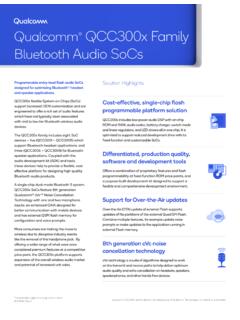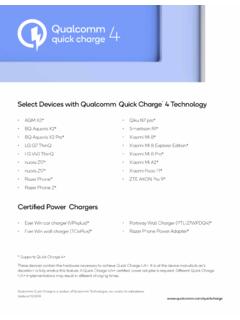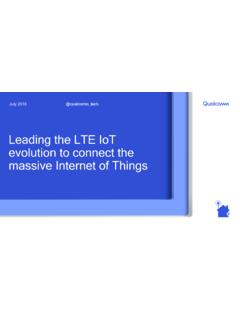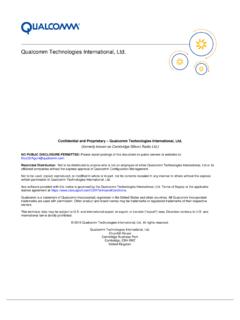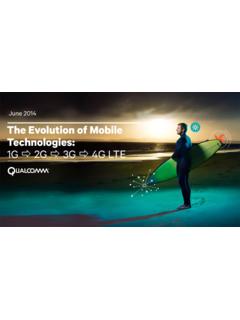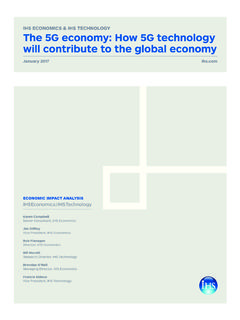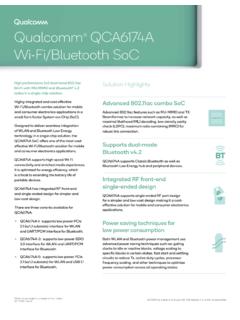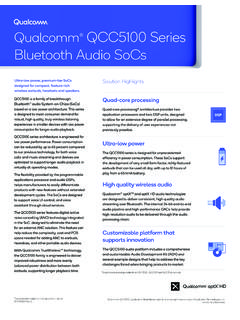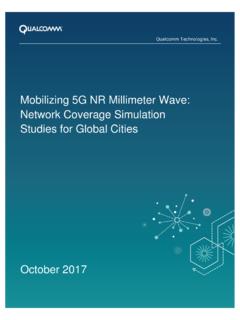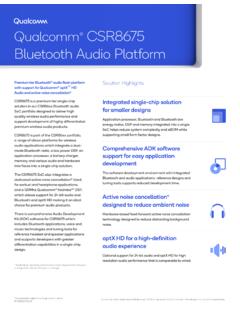Transcription of White Paper: Exploring 5G New Radio: Use Cases ...
1 White Paper Exploring 5G new radio : Use Cases , capabilities & timeline Prepared by Gabriel Brown Senior Analyst, Heavy Reading on behalf of September 2016 HEAVY READING | SEPTEMBER 2016 | White PAPER | Exploring 5G new radio : USE Cases , capabilities & timeline 2 5G new radio for Performance & Flexibility 5G new radio ( , 5G NR) is the name for the new air interface being developed to enable advanced 5G services. The radio is a critical component of 5G networks and is fundamental to determining the types of services 5G will be able to support.
2 Development of NR is underway, both in R&D labs and in standards. Major industry players are investing substantial sums in research and product design and the first prototype systems are now available for testing and evaluation. In parallel, the global standards body, the 3 GPP, is aiming to release its first NR specifications by mid-2018. The objective is to create a scalable air interface that can address the extreme variation of 5G applications and to develop a flexible design that will make 5G NR forward compatible to new service types in the future.
3 This White paper explores the key features of 5G NR, as understood at this stage of development. It addresses the capabilities NR will use to support diverse performance requirements at a low operational cost, with a focus on nearer-term deployment of enhanced mobile broadband (eMBB), and on how to make 5G NR wireless links indistinguishable from wireline broadband. It also discusses NR features that will enable innovative services and help insert 5G into new industrial value chains. 5G Use Cases & Performance Targets High-level performance targets for 5G are shown in Figure 1.
4 These targets were developed as part of the IMT-2020, the International Telecommunications Union (ITU) initiative to define "5G." They are mapped to three different classes of use case : (1) enhanced mobile broadband (eMBB); (2) massive machine-type communica-tions (mMTC); and (3) ultra-reliable, low-latency communications (UR-LLC). Each use- case class supports various different services with similar performance re-quirements industrial automation and mission-critical communications both re-quire ultra-low-latency, for example while other services sit on the axes between Figure 1: IMT 2020 Performance Targets Source: ITU Recommendation ITU-R , September 2015 HEAVY READING | SEPTEMBER 2016 | White PAPER | Exploring 5G new radio : USE Cases , capabilities & timeline 3 points of the triangle.
5 These performance requirements are outlined to the right of Figure 1 and expressed in either absolute terms or relative to LTE Advanced. The promise of 5G NR is to be able to support a vastly expanded range of service types and be forward compatible to new services that may emerge. Phased Development of 5G new radio It is improbable that all the services envisaged for 5G could be, or should be, de-ployed at the same time. To operators (and vendors), prioritization is important. There is an industry-wide plan for a phased introduction of 5G in order to enable early launch of 5G services, and to make the development process manageable.
6 Initial specifications for NR are expected in mid-2018, as part of 3 GPP Release 15. The focus is on enabling fast launch of 5G for enhanced mobile broadband, with trials starting in late 2017, or early 2018, and commercial launch from 2019. In some Cases , operators will be able to deploy pre-standard equipment and launch ser-vices to customers ahead of this schedule for example, fixed wireless may be pos-sible from 2017 onward. It remains to be determined, but some UR-LLC and mMTC features may also be included in the first release. Importantly from an NR perspective, the first phase will provide the foundations for enhancements in later releases.
7 This means that decisions made being now on fun-damental aspects of NR such as waveform, frame structure and error correction will have a profound and long-term impact on the evolution of NR and future 5G services. The industry is, therefore, now in the critical phase of 5G development. New capabilities will be introduced with later 3 GPP releases. Release 16 specifica-tions are scheduled for the end of 2019, with ongoing iteration of 5G NR expected in subsequent years. As has been the case in the specification of 2G, 3G and 4G, the first release will be the start of a decade-long development cycle.
8 Spectrum for NR Any discussion of radio technologies must include spectrum. Broadly speaking, 5G can be thought of as targeting spectrum between 1-3 GHz (the classic mobile bands), between 3-6 GHz (emerging mobile bands), and above 6 GHz (the centi-meter-wave [cmWave] and millimeter-wave [mmWave] bands). The intent is to cre-ate a radio interface that can scale across this vast frequency range. This makes NR fundamentally different, and more ambitious, than prior generations. In the sub-6 GHz bands, 5G will typically target new spectrum in the first instance for example, the C-Band or 700 MHz in Europe, GHz in China, or 4 GHz in Japan and then re-farmed 2G/3G/4G spectrum over time.
9 Spectrum in these lower bands is relatively constrained, but these frequencies are critical to coverage, and to deliver wide-area services. It is expected that operators will be able to reuse existing cell site infrastructure (towers, power supply, upgraded backhaul, etc.) to enable rapid 5G deployment at manageable cost. The higher frequencies are also of great interest to 5G because of the vast amount of spectrum available in the cmWave and mmWave bands (often several hundred MHz of contiguous spectrum). Some of the first 5G deployments may be in these bands, particularly for small cell and fixed wireless access applications for example, the 28 GHz band is attracting attention in the and other progressive markets.
10 HEAVY READING | SEPTEMBER 2016 | White PAPER | Exploring 5G new radio : USE Cases , capabilities & timeline 4 Spectrum-sharing between different operators, and different radio systems, is increas-ingly important, and lightly licensed and unlicensed spectrum will be important in 5G NR. Initiatives in the 4G-LTE world, such as MulteFire and LTE-LAA in unlicensed spectrum, and the Citizens Broadband radio Service (CBRS) in the licensed shared-access GHz band, provide a foundation for shared spectrum in 5G. A Unified Air Interface To scale across a wide range of performance requirements, spectrum bands and deployment scenarios, operators require an air interface that is highly configurable.
